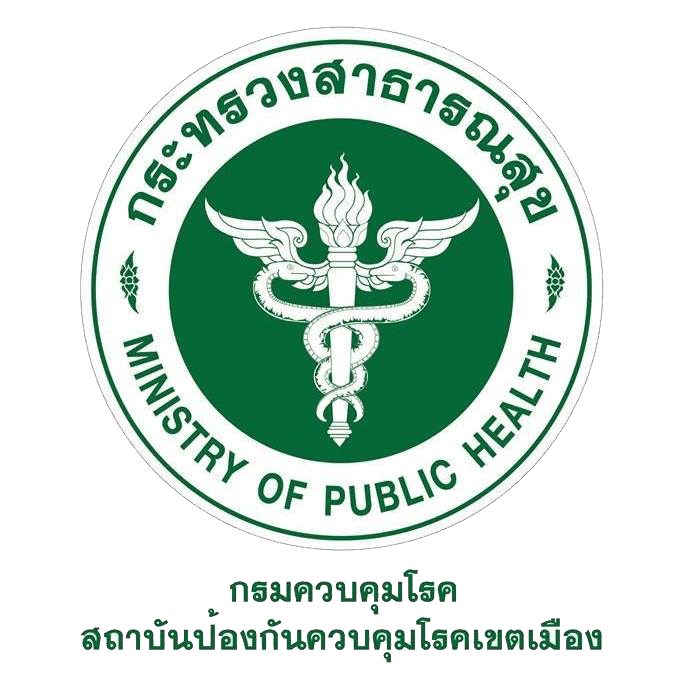การควบคุมการแพร่ระบาดของโรคติดเชื้อไวรัสโคโรนา 2019 ด้วยโมเดลการกักกันชุมชน Clean Community Anti Covid 2019; CCA กรณีศึกษา ชุมชนแออัดแห่งหนึ่ง เขตทวีวัฒนา กรุงเทพมหานคร
Main Article Content
บทคัดย่อ
เดือนเมษายน 2564 ประเทศไทยเผชิญวิกฤตการระบาดของโรคติดเชื้อไวรัสโคโรนา 2019 (โควิด-19) ระลอก 3 โดยเฉพาะกรุงเทพมหานคร ที่มีประชากรหนาแนน พบสายพันธุ์อังกฤษ หรือ B.1.1.7 ที่แพร่ระบาดได้รวดเร็วกว่าสายพันธุ์ปกติถึง 1.7 เท่า ผู้ป่วยไม่ได้แสดงอาการหลังจากได้รับเชื้อระยะแรก จนอาการรุนแรง ปัญหามากมายต่อการจัดสรรทรัพยากรทางการแพทย์ จากการสอบสวนโรคพบว่ามีการละเลยมาตรการดูแลสุขอนามัยส่วนบุคคล การเดินทางไปพื้นที่เสี่ยง การปกปิดข้อมูล และการกักตัว จนวันที่ 8 พฤษภาคม 2564 ทีมสอบสวนโรคได้รับแจ้งว่ามีผู้ป่วยติดเชื้อโควิด-19 ในชุมชนแออัด 1 ราย เสี่ยงต่อการแพร่ระบาดเป็นวงกว้างและออกนอกชุมชน เนื่องจากเป็นร้านค้า พักอาศัยหนาแน่น ผู้วิจัยจึงสนใจที่จะพัฒนาโมเดลการกักกันชุมชนเพื่อการควบคุมการระบาดของเชื้อไวรัสโคโรนา 2019 Clean Community Anti Covid 2019; CCA model โดยการมีส่วนร่วมของหน่วยงานภาครัฐและประชาชน วัตถุประสงค์ เพื่อศึกษามาตรการควบคุมการระบาดในชุมชนโดยการกักกันชุมชน (Community Quarantine) และพัฒนาแนวทางระบบการเฝ้าระวังควบคุมโรค วิธีการศึกษา การวิจัยครั้งนี้เป็นการวิจัยเชิงปฏิบัติการช่วงที่มีการระบาดระหว่างวันที่ 8 พฤษภาคม 2564 ถึง 4 มิถุนายน 2564 ตั้งแต่วันที่เริ่มพบผู้ป่วย,ติดตามผู้สัมผัสใกล้ชิด, ค้นหาผู้ป่วยเชิงรุก ตรวจหาเชื้อซ้ำในผู้สัมผัสเสี่ยงสูงหลังจากกักกันชุมชนครบ 14 วัน และ 21 วัน (หลังเปิดชุมชน 7 วัน) โดย Real time RT-PCR และตรวจหาแอนติบอดี
ผลการศึกษา พบว่าในชุมชนแห่งนี้มีพื้นที่ 4 ไร่ ประชากรทั้งหมด 196 ราย บ้าน 31 หลังคาเรือน ส่วนใหญ่เป็นเพศหญิง ร้อยละ 54.6 อายุเฉลี่ย 35.56 + 21.10 ตั้งแต่ 7 เดือน ถึง 86 ปี มีผู้ป่วยติดเชื้อ 38 ราย คิดเป็นร้อยละ 19.39 พบผู้ป่วยรายแรกในวันที่ 8 พฤษภาคม 2564 (CCA day 0) รายสุดท้าย 21 พฤษภาคม 2564 จากการตรวจซ้ำผู้สัมผัสเสี่ยงสูงร่วมบ้านผู้ป่วย ผู้ป่วยทั้ง 38 ราย อาศัยอยู่ตามบ้าน 7 หลัง มีความสัมพันธ์เครือญาติและทำกิจกรรมร่วมกับสมาชิกในบ้านของผู้ป่วยรายแรก ในบ้านแต่ละหลังมีจำนวนผู้ติดเชื้อคิดเป็นร้อยละ 50 – 100 ของจำนวนสมาชิกในแต่ละบ้าน พบสมาชิกทุกคนในบ้านมีการติดเชื้อ (100%) 3 หลัง จาก 7 หลัง (42.86%) พบการติดเชื้อตั้งแต่ครั้งแรกที่ตรวจ 35 ราย (64.81%) พบการติดเชื้อหลังจากตรวจซ้ำ 3 ราย (5.56%) เป็นผู้สัมผัสเสี่ยงสูงในบ้านที่มีผู้ป่วย หลังจาก CCA วันที่ 14 ได้ตรวจหาภูมิคุ้มกัน 160 ราย ไม่พบภูมิคุ้มกันขึ้น ในผู้สัมผัสเสี่ยงสูงร่วมบ้านผู้ป่วย 14 ราย (77.78%) และในชุมชน 135 ราย (98.54%) และCCA วันที่ 21 หลังเปิดชุมชน 7 วัน ทุกรายไม่พบว่ามีภูมิคุ้มกันขึ้น ดังนั้นหากเกิดการติดเชื้อโควิด 19 ในชุมชนแออัด ควรปฏิบัติตามมาตรการดังกล่าว
Article Details
บทความที่พิมพ์ในวารสารสถาบันป้องกันควบคุมโรคเขตเมือง ถือว่าเป็นผลงานวิชาการ งานวิจัยและวิเคราะห์ ตลอดจนเป็นความเห็นส่วนตัวของผู้เขียนเอง ไม่ใช่ความเห็นของสถาบันป้องกันควบคุมโรคเขตเมือง หรือคณะบรรณาธิการแต่ประการใด ผู้เขียนจำต้องรับผิดชอบต่อบทความของตน
เอกสารอ้างอิง
พระราชบัญญัติโรคติดต่อ พ.ศ.2558. เล่ม 132 ตอนที่ 86 ก 8 กันยายน 2558.
ประกาศกระทรวงสาธารณสุข เรื่อง ชื่อและอาการสำคัญของโรคติดต่ออันตราย (ฉบับที่ 3) พ.ศ. 2563 ลงวันที่ 26 กุมภาพันธ์ พ.ศ. 2563
ประกาศกระทรวงสาธารณสุข เรื่อง แต่งตั้งเจ้าพนักงานควบคุมโรคติดต่อ (ฉบับที่ 4) พ.ศ. 2563 ลงวันที่ 12 มีนาคม พ.ศ. 2563
สถานการณ COVID-19 ในประเทศไทย ขอมูล ณ วันที่ 10 เมษายน 2564. ศูนยขอมูล COVID-19 กรมประชาสัมพันธ https://web.facebook.com/informationcovid19/?_rdc=1&_rdr
SARS-CoV-2 Variant Classifications and Definitions https://www.cdc.gov/coronavirus/2019-ncov/cases-updates/variant-surveillance/variant-info.html เข้าถึงเมื่อ 1 พฤษภาคม 2564
Iacobucci, G. (2021). Covid-19: New UK variant may be linked to increased death rate, early data indicate. bmj, 372(230), n230.
สถานการณ COVID-19 ในประเทศไทย ขอมูล ณ วันที่ 8 พฤษภาคม 2564. ศูนยขอมูล COVID-19 กรมประชาสัมพันธ https://web.facebook.com/informationcovid19/?_rdc=1&_rdr
ธรณินทร์ คุณแขวน. 2555. การส่งเสริมสุขภาพผู้สูงอายุโดยการมีส่วนร่วมของชุมชนบ้านช่อระกา ตำบล นาฝาย อำเภอเมือง จังหวัดชัยภูมิ. วิทยานิพนธ์พยาบาลศาสตรมหาบัณฑิต, สาขาวิชาการพยาบาลเวชปฏิบัติชุมชน บัณฑิตวิทยาลัย มหาวิทยาลัยขอนแก่น.
สุรัยยา หมานมานะ, โสภณ เอี่ยมศิริถาวร, สุมนมาลย์ อุทยมกุล. โรคติดเชื้อไวรัสโคโรนา 2019 (COVID-19) วารสารสถาบันบำราศนราดูร ปีที่ 14 ฉบับที่ 2 พฤษภาคม-สิงหาคม 2563
Wang, P. (2020). Combination of serological total antibody and RT-PCR test for detection of SARS-COV-2 infections. Journal of virological methods, 283, 113919.
ปรีดา แต้อารักษ์, จันทนา เบญจทรัพย์, ขจีรัตน์ ปรักเอโก, สมเกียรติ พิทักษ์กมลพร, ทิพิชา โปษยานนท์, กนกวรรณ รับพรดี และคณะ. แนวปฏิบัติในการปองกันและเฝาระวังโรคโควิด-19 ของชุมชน รวมพลังพลเมืองตื่นรู สูภัยโควิด-19 ระลอก 3. นนทบุรี: สำนักงาน คณะ กรรมการ สุขภาพ แห่ง ชาติ (ส ช), สำนัก วิชาการ และ นวัตกรรม (สวน.); 2564
เกตุดาว ร, เที่ยงตรงดี อ, โทอินทร์ ภ. Development of Covid-19 Surveillance Prevention and Control Model Health Promoting Hospital in Sub-district Level, Udonthani Province-Udon Model COVID-19-การพัฒนารูปแบบการเฝ้าระวังป้องกันและควบคุมโรคติดเชื้อไวรัสโคโรนา 2019. J Health Sci [Internet]. 2021Feb.25 [cited 2021Jun.13];30(1):53-61. เข้าถึงจาก: https://thaidj. org/index.php/JHS/article/view/9845
Prasetyo, Y. T., Castillo, A. M., Salonga, L. J., Sia, J. A., & Seneta, J. A. (2020). Factors affecting perceived effectiveness of COVID-19 prevention measures among Filipinos during enhanced community quarantine in Luzon, Philippines: Integrating Protection Motivation Theory and extended Theory of Planned Behavior. International journal of infectious diseases, 99, 312-323.
กิตติพร เนาว์สุวรรณ. (2563). ความสัมพันธ์ระหว่างการรับรู้ความรุนแรงของโรคต่อบทบาทการดำเนินงานควบคุมโรคติดเชื้อไวรัสโคโรนา 2019 ในชุมชนของอาสาสมัครสาธารณสุขประจำหมู่บ้าน (อสม.) ในประเทศไทย. วารสารสถาบันบำราศนราดูร, 14(4), 92-103.
เยาวลักษณ์ ชาวบ้านโพธิ์. (2563) บทบาทของอาสาสมัครสาธารณสุขประจําหมู่บ้านในการป้องกันการระบาดโรคติดเชื้อไวรัสโคโรนาสายพันธุ์ใหม่ 2019 อําเภอพระประแดง จังหวัดสมุทรปราการ. วารสารรัฐประศาสนศาสตร์ มหาวิทยาลัยราชภัฏสวนสุนันทา, 4(1), 44-58.


